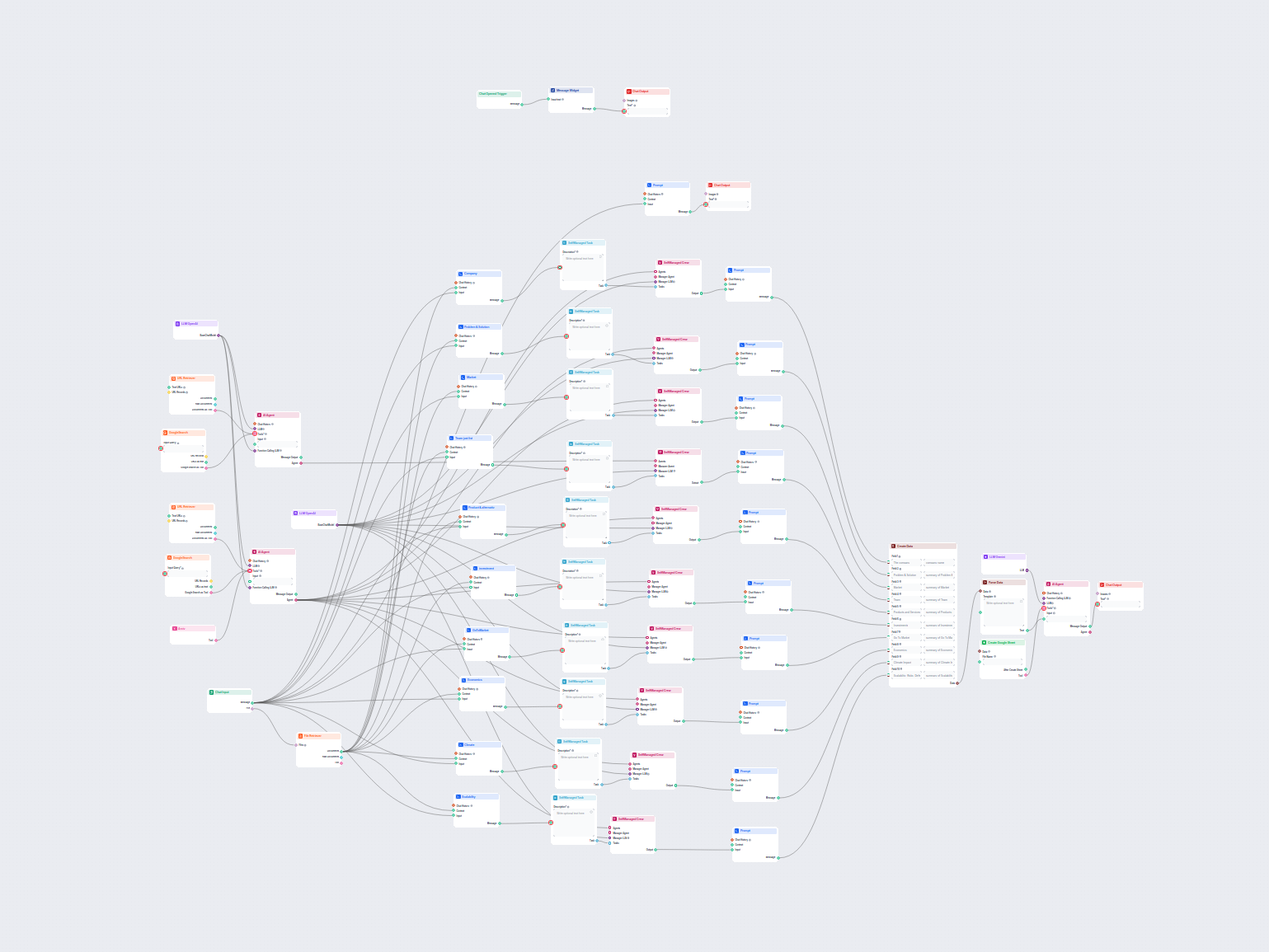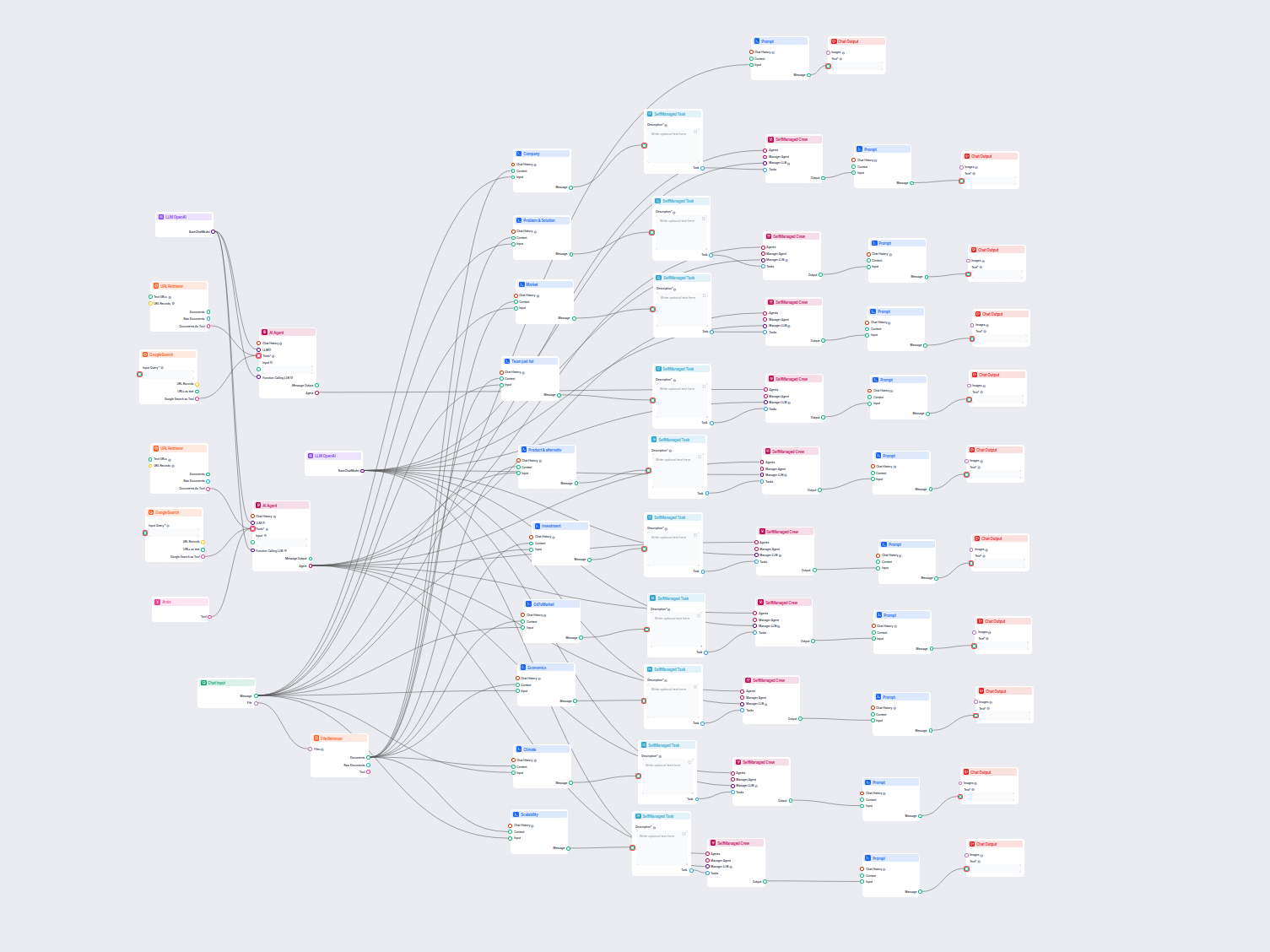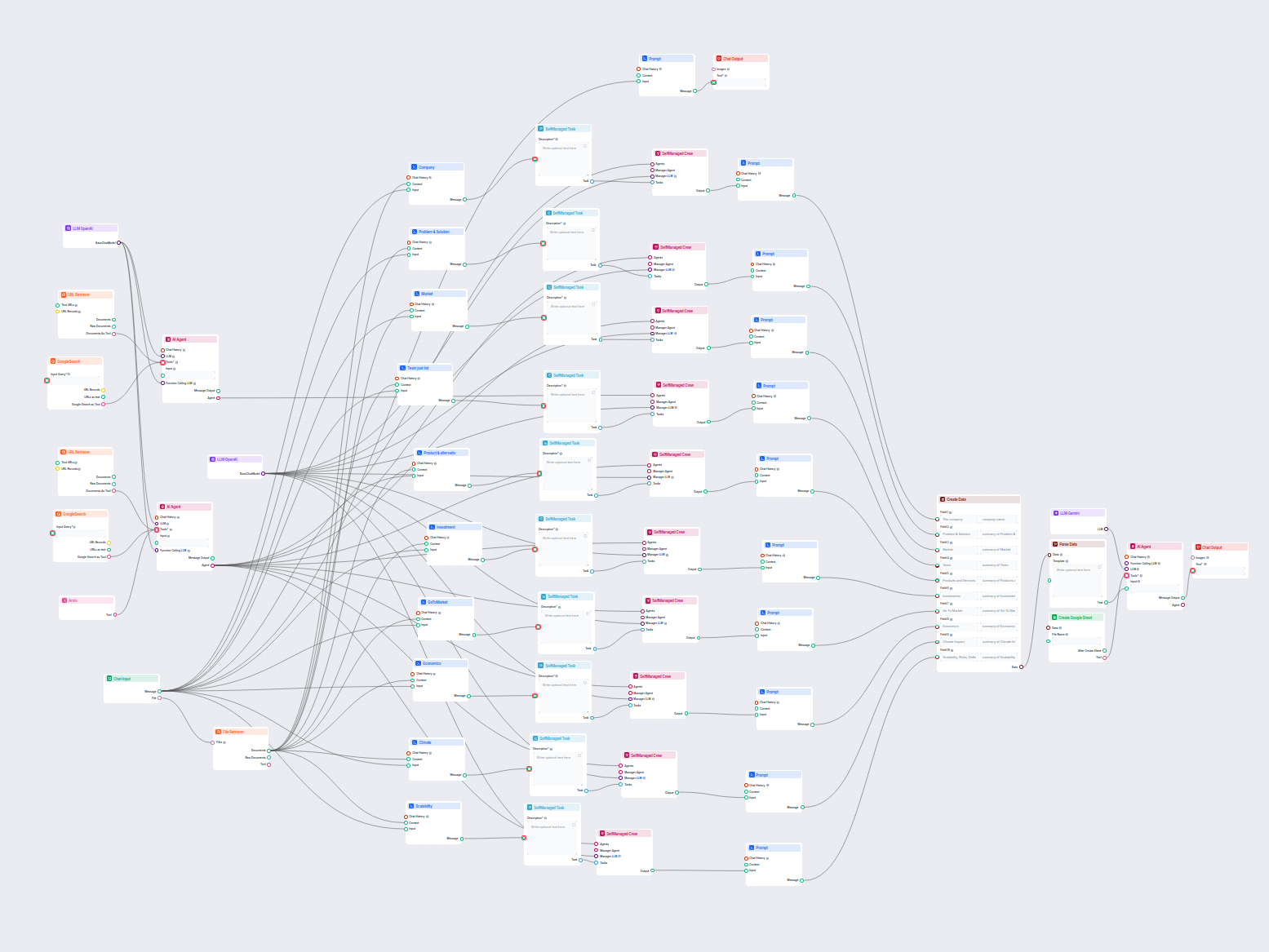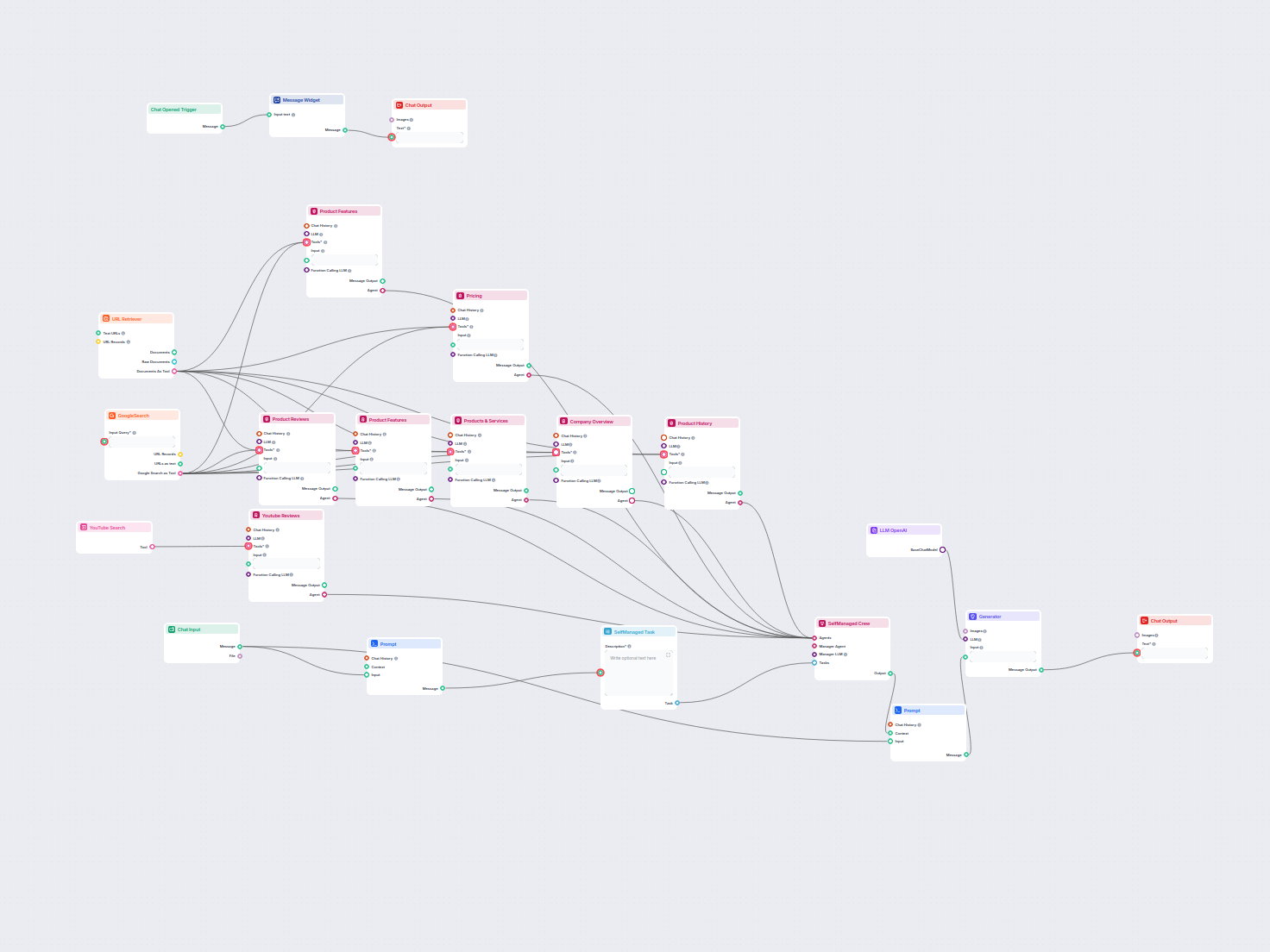AI-Powered Company Analysis & Google Sheets Export
This AI workflow analyzes any company in depth by researching public data and documents, covering market, team, products, investments, and more. It synthesizes findings into a structured report and automatically exports results to a Google Sheet for further use. Ideal for sales, marketing, and investment research teams.


Flows
How the AI Flow works
- User Input and Welcome.
- User provides a company name for analysis. The flow welcomes the user and collects any relevant files.
- Data Gathering & Research.
- AI agents search Google and extract information from relevant web pages and uploaded documents. Additional research tools like Arxiv are available.
- Automated Company Analysis.
- The workflow analyzes key aspects such as company overview, market, products, team, competition, investments, go-to-market strategy, economics, and climate impact using AI.
- Structured Report Generation.
- All findings are synthesized into a structured, multi-section company report. Data is parsed and organized for export.
- Export to Google Sheets.
- The final company analysis is automatically exported to a Google Sheet for sharing, tracking, or further processing.
Prompts used in this flow
Below is a complete list of all prompts used in this flow to achieve its functionality. Prompts are the instructions given to the AI model to generate responses or perform actions. They guide the AI in understanding user intent and generating relevant outputs.
Prompt
A prompt template that creates a heading with 'The company' and includes the input.
## The company
{input}
Company
Prompt for extracting company overview, history, and achievements, with sources.
Given the company name in the input, Extract the following data about company.
- About the company (Short Overview of what the company does)
- Company History (short history in bulletpoints)
- Notable Achievements (Description of key achievements or the company, awards won, articles and press mentions in respected media, etc ) - with links to source
Don't use abbreviations
---
COMPANY NAME:
{input}
---
Internal documents:
{context}
---
Problem & Solution
Prompt for extracting the company's problem and solution.
Given the company name in the input, Extract the following data about company.
- Problem (Simple description of the problem that the company identified and aims to solve.)
- Solution (High level description of the solution that the company built or is building)
Don't use abbreviations
---
COMPANY NAME:
{input}
---
Internal documents:
{context}
---
Market
Prompt for extracting target market, opportunities, and competition information.
Given the company name in the input, Extract the following data about company.
- Segment, Focus (who is target customer of the company)
- Point out what is target Market for company,
- market background,
- market size
- market opportunities
- Competition (Who are the key companies that seem to be competing on the same market or for the same use cases. Describe the competitor, their size, revenue and funding raised. Identify top market leaders for their market segment)
Don't use abbreviations
---
COMPANY NAME:
{input}
---
Internal documents:
{context}
---
Team just list
Prompt for extracting a list of team members and their roles by searching online.
Given the company name in the input, Extract the following data about company.
based on the company, search in google and look to the content of urls and find the team members in the company
list the name of all team members and their role in the company.
do this for 1 or 2 important individuals in the company
Don't use abbreviations
---
COMPANY NAME:
{input}
---
Internal documents:
{context}
---
Product & alternativ
Prompt for extracting company products, alternatives, and competitive advantages.
Given the company name in the input, Extract the following data about company.
- Main company products or services (Describe key elements and features of the product proposition.)
- Product alternatives and competitors (with links to websites of alternative services and products to input company)
- list advantages against competitors
Don't use abbreviations
---
COMPANY NAME:
{input}
---
Internal documents:
{context}
---
investment
Prompt for extracting investment and fundraising details of a company.
Given the company name in the input, Extract the following data about company.
- Funding raised to date (Amount, who were the investors)
- if investors identified, for each investor make short summary of their investment portfolio, find link to their website
- Fundraising Details (How much did the company raise in previous rounds to date and in how many rounds. Did the company secure non-dilutive funding, grants or tenders?)
- Existing/upcoming funding round, How much is the company raising? What is the expected valuation?
Don't use abbreviations
---
COMPANY NAME:
{input}
---
Internal documents:
{context}
---
Economics
Prompt for extracting unit economics, revenue, and traction data.
Given the company name in the input, Extract the following data about company.
- Unit economics and Cost Break-down (What are the top cost drivers per unit of product once the product goes live and after it scales (e.g. 3-5 years later). What is the cost break-down for competitors?)
- Revenue (in case the company is generating revenue, show here the key numbers to date and also show revenue projection of the company for the next 3-5 years.)
- Traction (Mention key notable traction based milestones achieved so far (pilot projects, partnership agreements, etc).)
Don't use abbreviations
---
COMPANY NAME:
{input}
---
Internal documents:
{context}
---
GoToMarket
Prompt for extracting go-to-market, business model, and timing information.
Given the company name in the input, Extract the following data about company.
- Technology Readiness Level (TRL)
- Go to market/Distribution strategy (What is the go to market strategy? How does the company (plan to) to get customers?)
- Business Model (Explain how the company plans to generate revenue, what is their pricing model and what are their costs (customer acquisition costs, etc).)
- Timing (Describe if the company has the right timing (or not). Are there any market shifts happening that might massively help the company grow and scale? )
Don't use abbreviations
---
COMPANY NAME:
{input}
---
Internal documents:
{context}
---
Climate
Prompt for extracting company’s impact on climate, especially related to greenhouse gas emissions.
Given the company name in the input, Extract the following data about company.
- Impact on Climate (Does the company have a direct impact on lowering greenhouse gas emissions? Describe a way how the impact is achieved)
Don't use abbreviations
---
COMPANY NAME:
{input}
---
Internal documents:
{context}
---
Scalability
Prompt for extracting scalability, defensibility, and key risks about the company.
Given the company name in the input, Extract the following data about company.
- Scalability (Is the company scalable globally and how hard/easy do we expect it to be?)
- Defensibility (Is the business of the company defensible and why?)
- Key Risks (Describe key risks of the company.)
Don't use abbreviations
---
COMPANY NAME:
{input}
---
Internal documents:
{context}
---
Components used in this flow
Below is a complete list of all components used in this flow to achieve its functionality. Components are the building blocks of every AI Flow. They allow you to create complex interactions and automate tasks by connecting various functionalities. Each component serves a specific purpose, such as handling user input, processing data, or integrating with external services.
ChatInput
The Chat Input component in FlowHunt initiates user interactions by capturing messages from the Playground. It serves as the starting point for flows, enabling the workflow to process both text and file-based inputs.
Message Widget
The Message Widget component displays custom messages within your workflow. Ideal for welcoming users, providing instructions, or showing any important information, it supports Markdown formatting and can be set to appear only once per session.
Chat Output
Discover the Chat Output component in FlowHunt—finalize chatbot responses with flexible, multi-part outputs. Essential for seamless flow completion and creating advanced, interactive AI chatbots.
Prompt Component in FlowHunt
Learn how FlowHunt's Prompt component lets you define your AI bot’s role and behavior, ensuring relevant, personalized responses. Customize prompts and templates for effective, context-aware chatbot flows.
FileContent
SelfManaged Task
The SelfManaged Task component enables users to define and execute autonomous tasks within a workflow. Specify a clear task description, expected outcome, and assign an agent to manage execution—ideal for building structured, hierarchical automation in your flows.
Self-Managed Crew
Unlock advanced collaboration in FlowHunt with the Self-Managed Crew component. Coordinate multiple AI agents under a manager agent to autonomously handle complex workflows and hierarchical tasks, maximizing efficiency and scalability.
AI Agent
The AI Agent component in FlowHunt empowers your workflows with autonomous decision-making and tool-using capabilities. It leverages large language models and connects to various tools to solve tasks, follow goals, and provide intelligent responses. Ideal for building advanced automations and interactive AI solutions.
LLM OpenAI
FlowHunt supports dozens of text generation models, including models by OpenAI. Here's how to use ChatGPT in your AI tools and chatbots.
LLM Gemini
FlowHunt supports dozens of AI models, including Google Gemini. Learn how to use Gemini in your AI tools and chatbots, switch between models, and control advanced settings like tokens and temperature.
GoogleSearch Component
FlowHunt's GoogleSearch component enhances chatbot accuracy using Retrieval-Augmented Generation (RAG) to access up-to-date knowledge from Google. Control results with options like language, country, and query prefixes for precise and relevant outputs.
URL Retriever
Unlock web content in your workflows with the URL Retriever component. Effortlessly extract and process the text and metadata from any list of URLs—including web articles, documents, and more. Supports advanced options like OCR for images, selective metadata extraction, and customizable caching, making it ideal for building knowledge-rich AI flows and automations.
Create Data
The Create Data component enables you to dynamically generate structured data records with a customizable number of fields. Ideal for workflows that require the creation of new data objects on the fly, it supports flexible field configuration and seamless integration with other automation steps.
Parse Data
The Parse Data component transforms structured data into plain text using customizable templates. It enables flexible formatting and conversion of data inputs for further use in your workflow, helping to standardize or prepare information for downstream components.
Create Google Sheet
Easily generate new Google Sheets directly within your workflow. The Create Google Sheet component lets you input structured data and instantly create spreadsheets, making it simple to automate data collection, reporting, or sharing results. Integrate with other components to streamline your business and productivity tasks.
ArXiv Tool
Effortlessly chat with 2.4M scholarly articles using FlowHunt's ArXiv Tool and AI Agents. Revolutionize your research by matching queries with concise responses from the ArXiv database and enhance your chatbot with customizable flows.
Flow description
Purpose and benefits
Overview
This workflow is designed to automate and scale the process of company analysis, particularly for startups or companies under research or investment consideration. It leverages AI agents, prompt engineering, web search, data retrieval, and structured data export to Google Sheets. The flow takes a company name as input and systematically gathers, analyzes, and structures a wide range of information about the company from public and uploaded sources.
Step-by-Step Breakdown
1. User Interaction & Input Collection
- User Initiation: When a user opens the chat or playground, a welcome message is shown, explaining the tool’s capabilities and prompting for a company name.
- Input Interface: The user enters the company name (and optionally uploads documents) via the chat input component.
2. Information Gathering
Prompt Templates: The workflow uses multiple prompt templates, each tailored to extract a specific aspect of company information, such as:
- Company overview and history
- Problem & solution the company addresses
- Market analysis (target market, size, competition)
- Team structure and key members
- Products & services, alternatives, and competitive advantages
- Funding and investment details
- Go-to-market strategy, business model, and timing
- Economics, cost structure, revenue, traction
- Climate impact
- Scalability, defensibility, and risks
Contextual Data: Uploaded files (e.g. company presentations, pitch decks) are processed and their content is made available as additional context to enhance the accuracy of the analysis.
Automated Web Research: AI agents utilize Google Search to find public information, news, and profiles related to the company. They also retrieve and process the content of found URLs.
3. AI Agents & Task Automation
- Self-Managed Tasks and Crews: Tasks are defined for each analytical area, specifying the expected output (e.g., “Thorough report of the company giving out needed data”).
- Hierarchical Crews: Groups of AI agents (crews) are managed by a manager agent and a language model (LLM, e.g. OpenAI GPT-4o-mini), and are responsible for executing the analytical tasks in parallel, allowing for scalability and speed.
- Agent Specialization: Some agents have specific backstories and goals, such as researching team members or critically analyzing company data.
4. Data Structuring
- Data Aggregation: The outputs from all analysis prompts are collected and mapped into structured fields using a “Create Data” component. Each field corresponds to an analytical category (see the table below).
| Field | Description |
|---|---|
| The company | Company overview, history, achievements |
| Problem & Solution | Problem addressed, solution description |
| Market | Target segment, market size, competition |
| Team | List and roles of key team members |
| Products and Services | Main products/services, alternatives |
| Investments | Funding details, investors, fundraising |
| Go To Market | Distribution, business model, timing |
| Economics | Cost structure, revenue, traction |
| Climate Impact | Environmental impact |
| Scalability, Risks… | Scalability, risks, defensibility |
- Parsing for Output: The structured data is then parsed into plain text for further processing or display.
5. Export & Automation
Google Sheets Automation: An AI agent (with a “Google Sheets expert” backstory) takes the structured data and automatically generates a Google Sheets file, making it easy to export, share, and analyze the results in a familiar format.
Output Display: The final output, including links to the generated Google Sheets and text summaries, is displayed in the chat interface.
Why This Workflow is Useful for Scaling and Automating Company Analysis
Parallel Task Execution: By splitting the analysis into modular prompts and delegating them to crews of AI agents, the workflow can analyze multiple companies or multiple aspects of a company in parallel, significantly reducing manual effort and turnaround time.
Consistent, Comprehensive Outputs: The use of structured prompts ensures that each analysis is thorough and covers all critical dimensions, minimizing information gaps or subjective bias.
Dynamic Data Gathering: By integrating web search and document retrieval, the system can always access the most recent public information alongside any internal documents.
Seamless Export: Automated generation of Google Sheets files enables easy scaling to batch analyses and integration with existing workflows for reporting, investment evaluation, or due diligence.
Adaptable & Extensible: New analysis areas can be added simply by creating new prompt templates and tasks, making the system flexible for evolving needs.
Example Use Cases
- Venture Capital & Startup Scouting: Rapidly analyze hundreds of startups for investment screening.
- Consulting & Market Research: Produce consistent company profiles for clients.
- Competitive Intelligence: Track competitors across multiple analytical dimensions.
- Portfolio Management: Update and maintain structured records of portfolio companies.
Summary Table: Key Components & Their Roles
| Component | Role |
|---|---|
| Chat Input/Output | User interaction, data entry, and results display |
| Message Widget | Welcome and guidance messages |
| Prompt Templates | Structured extraction of company information |
| File/URL Retrievers | Add context from web or uploaded files |
| AI Agents | Execute research and analytical tasks |
| Self-Managed Crews | Organize agents for parallel, scalable execution |
| Create Data | Aggregate all findings into a structured format |
| Google Sheets Export | Automate export of results for further use |
In Summary
This workflow transforms a manual, time-consuming company analysis task into an automated, scalable, and highly repeatable process. By combining AI-driven research, structured prompt engineering, and seamless data export, it empowers users to generate rich, actionable company profiles with minimal effort. This is invaluable for any organization needing to process large volumes of company data quickly and consistently.
Let us build your own AI Team
We help companies like yours to develop smart chatbots, MCP Servers, AI tools or other types of AI automation to replace human in repetitive tasks in your organization.
Learn more

AI Company Analysis & Market Research
Comprehensive AI-driven workflow for company analysis and market research. Automatically gathers and analyzes data on company background, market position, produ...

AI Company Analysis to Google Sheets
This AI-powered workflow delivers a comprehensive, data-driven company analysis. It gathers information on company background, market landscape, team, products,...

AI Product Analysis Generator
Generate comprehensive product analyses using AI agents that gather and summarize product information, pricing, features, reviews, alternatives, and more from p...
